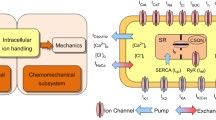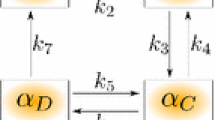Abstract
The in vitro spontaneous contractions of human myometrium samples can be described using a phenomenological model involving different cell states and adjustable parameters. In patients not receiving hormone treatment, the dynamic behavior could be described using a three-state model similar to the one we have already used to explain the oscillations of intra-uterine pressure during parturition. However, the shape of the spontaneous contractions of myometrium from patients on progestin treatment was different, due to a two-step relaxation regime including a latched phase which cannot be simulated using the previous model without introducing an ad hoc mechanism to account for the extra energy involved in this sustained contraction. One way to do this is to introduce an anomalous rate of ATP consumption, the biochemical reasons for which have not yet been elucidated and which cannot be mathematically simulated using our experimental data. An alternative explanation is the reduced cycling rate of actin-myosin cross-bridges known to occur during the latch-phase. Our experimental findings suggest a third possibility, namely a sol-gel transition with a specific relaxation time constant, which would maintain a significant part of the cell population in the contracted-state until the intracellular-medium returns to its normal fluid behavior.
Similar content being viewed by others
REFERENCES
Chalovich, J.M. and G. Pfitzerg (1997). Structure and function of the filament proteins of smooth muscle. In: Kao, C.Y. and M.E. Carsten (Ed.). Cellular aspects of smooth muscle function. pp. 235-287. Cambridge University Press, Cambridge.
Ferré, F. (1997). Molecular mechanisms of parturition. Infectious Diseases in Obstetrics and Gynecology 5: 98-105.
Fu, X., M. Rezapour, M. Löfgren, U. Ulmsten and T. Bläckström (1993). Unexpected stimulatory effect of progesterone on human myometrial contractile activity in vitro. Obstetrics and Gynecology: 82: 23-28.
Haeberle, J.R., D.R. Hathaway and A.A. DePaoli-Roach (1985). Dephosphorylation of myosin by the catalytic subunit of a type-2 phosphatase produces relaxation of chemically skinned uterine smooth muscle. The Journal of Biological Chemistry 260: 9965-9968.
Hai, C. M. and R.A. Murphy (1988a). Cross-bridge phosphorylation and regulation of latch state in smooth muscle. American Journal of Physiology Society 254: C99-C106.
Hai, C. M. and R.A. Murphy (1988b). Regulation of shortening velocity by cross-bridge phosphorylation in smooth muscle. American Journal of Physiology Society 255: C89-C94.
Hawk, H.W., J.B. Bitman, H.C. Cecil, J.N. Wiltbank, J. Bond and J.K. Sykes (1961). Effect of ovarian hormones on water electrolytes in the cow uterus. American Journal of Physiology 200: 345-347.
Héluy, V., G. Germain, T Fournier, F. Ferré and M. Breuiller-Fouché (1995). Endothelin ETA receptors mediate human uterine smooth muscle contraction. European Journal of Pharmacology 285: 89-94.
Huxley, A.F. (1957). Muscle structure and theories of contraction. Progress in Biophysics and Chemistry 7: 255-318.
Huxley, A.F. (2000). Mechanics and models of the myosin motor. Philosophical Transactions of the Royal Society of London; Series A: mathematical, physical and engineering sciences 355: 433-440.
Kawagushi, K., S. Fuji, I. Konishi, H. Okamura and T. Mori (1985). Ultrastructural study of cultured smooth muscle cells from uterine leiomyoma and myometrium under the influence of sex steroids. Gynecologic Oncology 21: 32-41.
Kelly, R.E. and H.G. Verhage (1981). Hormonal effects on the contractile apparatus of the myometrium. American Journal of Anatomy 161: 375-382.
Kilarski, W. M., X. Fu, T. Bläckström, G.M. Roomans and U. Ulmsten (1996). Progesterone, œstradiol and oxytocin and their in vitro effect on maintaining the number of gap junction plaques in human myometrium at term. Acta Physiologica Scandinavica 157: 461-469.
Lange, C.A., J.K. Richer and K.B. Horwitz (1999). Hypothesis: progesterone primes breast cancer cells for cross-talk with proliferative or antiproliferative signals. Molecular Endocrinology 13: 829-836.
Meiss, R.A. (1997). Mechanics of smooth muscle contraction. In: Kao, C.Y. and M.E Carsten (Ed.). Cellular aspects of smooth muscle function. pp. 169-208. Cambridge University Press, Cambridge.
Perusquia, M., R. Hernandez, J. Jasso-Kamel and M. Rodriguez-Rabago (1997). Relaxing effect of progestins on spontaneous contractile activity of gravid human uterus. Medicine Science Research 25: 585-587.
Riemer, R.K. and M.A. Heymann (1998). Regulation of uterine smooth muscle function during gestation. Pediatric Research 44: 615-627.
Singer, H. A. and R.A. Murphy (1987). Maximal rates of activation in electrically stimulated swine carotid media. Circulation Research 60: 438-445.
Sornette, D., F. Ferré and E. Papiernik (1994). Mathematical model of human gestation and parturition. Implication for early diagnostic of prematurity and post—maturity. International Journal of Bifurcation and Chaos 43: 693-699.
Sornette, D., B. Carbonne, F. Ferré., C. Vauge and E. Papiernik (1995). Modèle mathématique de la parturition humaine. Médecine Sciences 8: 1150-1153.
Stossel, T.P. (1993). On the crawling of animal cells. Science 260: 1086-1094.
Taggart, M.J. and S. Wray (1998). Hypoxia and smooth muscle function: key regulatory events during metabolic stress. Journal of Physiology 509: 315-325.
Tchirikov, M., U. Peiper and H.J Schröder (2000). Contraction kinetics of isolated human myometrium during menstrual cycle and pregnancy. British Journal of Obstetrics and Gynecology 107: 62-67.
Vauge, C., B. Carbonne, E. Papiernik and F. Ferré (2000). A Mathematical Model of Uterine Dynamics and Its Application to Human Parturition. Acta Biotheoretica 48: 95-105.
Wray, S. (1993). Uterine contraction and physiological mechanism of modulation. American Journal of Physiology 264: C1-C18.
Yang, L., S.Y. Wang and C.Y. Kao (1994). Regulation by ovarian hormones of the large-conductance Ca2+ — activated K+ channels of freshly dissociated rabbit uterine myocytes. Biophysical Journal 66: A 438.
Yu, S.N., P.E. Crago and H.J. Chiel (1997). A nonisometric kinetic model for smooth muscle. American Journal of Physiology 272: C1025-C1039.
Author information
Authors and Affiliations
Rights and permissions
About this article
Cite this article
Vauge, C., Mignot, TM., Paris, B. et al. A Mathematical Model for the Spontaneous Contractions of the Isolated Uterine Smooth Muscle from Patients Receiving Progestin Treatment. Acta Biotheor 51, 19–34 (2003). https://doi.org/10.1023/A:1023048205232
Issue Date:
DOI: https://doi.org/10.1023/A:1023048205232




